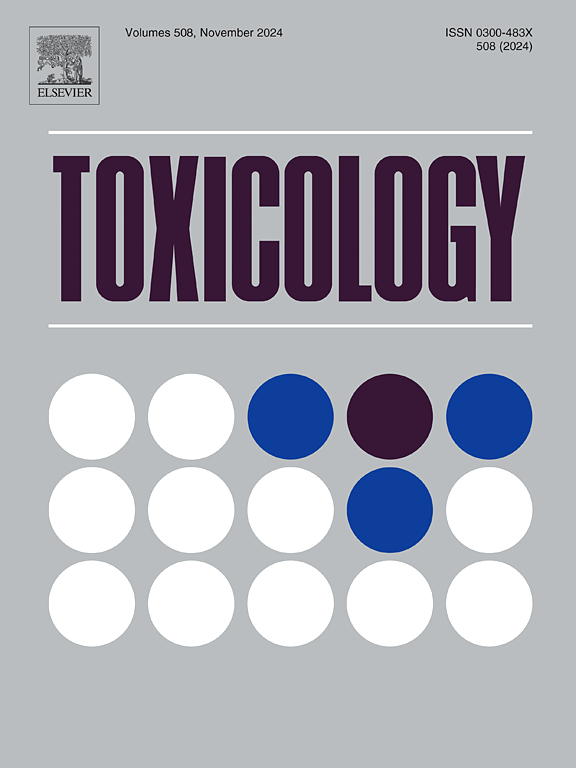PFBS破坏人滋养层细胞的脂质代谢和线粒体功能。
IF 4.6
3区 医学
Q1 PHARMACOLOGY & PHARMACY
引用次数: 0
摘要
全氟丁烷磺酸(PFBS)是一种新兴的短链单氟烷基和多氟烷基物质(PFAS),是一组与不利生殖结果相关的持久性环境污染物。胎盘在妊娠并发症的发病机制中起着关键作用,胎盘破裂与PFBS暴露于这些疾病之间的机制途径有关。特别是,胎盘线粒体功能在妊娠期间得到完善,以优化胎儿和胎盘的动态生长。因此,线粒体功能的破坏可能介导环境暴露对妊娠结局的不利影响。本研究探讨了PFBS对人胎盘主要的营养转运细胞——合体滋养细胞(syncytiotrophocell, STB)代谢和线粒体功能的影响。利用人滋养细胞干细胞模型,我们将细胞分化为stb,并将其暴露于环境相关剂量的PFBS(100µM)中24小时。转录组学(RNA-seq)分析鉴定出22个下调基因和10个上调基因(FDR < 0.05)。综合转录组学和代谢组学分析显示,PFBS显著破坏了脂质代谢,特别是下调了胎盘脂质稳态的关键调节因子PPARG,以及对线粒体脂肪酸进口至关重要的肉碱穿梭基因CPT1A和SLC25A20。进一步的功能评估发现线粒体DNA拷贝数增加,但ATP产生减少,表明线粒体功能障碍。然而,PFBS暴露不会诱导氧化应激,也不会改变线粒体形态。这些发现表明,PFBS主要通过破坏脂质代谢和线粒体能量产生来诱导人类STBs的代谢毒性。这一机制可能是观察到的PFBS暴露、胎盘功能障碍和不良妊娠结局之间关联的基础。本文章由计算机程序翻译,如有差异,请以英文原文为准。
PFBS disrupts lipid metabolism and mitochondrial function in human trophoblast cells
Perfluorobutanesulfonic acid (PFBS) is an emerging short-chain per- and polyfluoroalkyl substance (PFAS), a group of persistent environmental contaminants associated with adverse reproductive outcomes. The placenta plays a critical role in the pathogenesis of pregnancy complications, and disrupted placentation is implicated in the mechanistic pathways linking PFBS exposure to these disorders. In particular, placental mitochondria function refines during pregnancy to optimize the dynamic growth of the fetus and placenta. Disruptions in mitochondrial function may therefore mediate the adverse effects of environmental exposure on pregnancy outcomes. This study investigated the effects of PFBS on the metabolism and mitochondrial function of human syncytiotrophoblast (STB), the primary nutrient-transporting cells of the placenta. Using a human trophoblast stem cell model, we differentiated cells into STBs and exposed them to an environmentally relevant dose of PFBS (100 µM) for 24 h. Transcriptomic (RNA-seq) analysis identified 22 downregulated genes and 10 upregulated genes (FDR < 0.05). Integrated transcriptomic and metabolomic analyses revealed that PFBS significantly disrupted lipid metabolism, notably downregulating PPARG, a key regulator of placental lipid homeostasis, and carnitine shuttle genes CPT1A and SLC25A20, which are essential for mitochondrial fatty acid import. Further functional assessments found increased mitochondrial DNA copy number, yet decreased ATP production, indicating mitochondrial dysfunction. However, PFBS exposure did not induce oxidative stress nor alter mitochondrial morphology. These findings demonstrate that PFBS induces metabolic toxicity in human STBs, primarily by disrupting lipid metabolism and mitochondrial energy production. This mechanism may underlie the observed associations between PFBS exposure, placental dysfunction, and adverse pregnancy outcomes.
求助全文
通过发布文献求助,成功后即可免费获取论文全文。
去求助
来源期刊

Toxicology
医学-毒理学
CiteScore
7.80
自引率
4.40%
发文量
222
审稿时长
23 days
期刊介绍:
Toxicology is an international, peer-reviewed journal that publishes only the highest quality original scientific research and critical reviews describing hypothesis-based investigations into mechanisms of toxicity associated with exposures to xenobiotic chemicals, particularly as it relates to human health. In this respect "mechanisms" is defined on both the macro (e.g. physiological, biological, kinetic, species, sex, etc.) and molecular (genomic, transcriptomic, metabolic, etc.) scale. Emphasis is placed on findings that identify novel hazards and that can be extrapolated to exposures and mechanisms that are relevant to estimating human risk. Toxicology also publishes brief communications, personal commentaries and opinion articles, as well as concise expert reviews on contemporary topics. All research and review articles published in Toxicology are subject to rigorous peer review. Authors are asked to contact the Editor-in-Chief prior to submitting review articles or commentaries for consideration for publication in Toxicology.
 求助内容:
求助内容: 应助结果提醒方式:
应助结果提醒方式:


